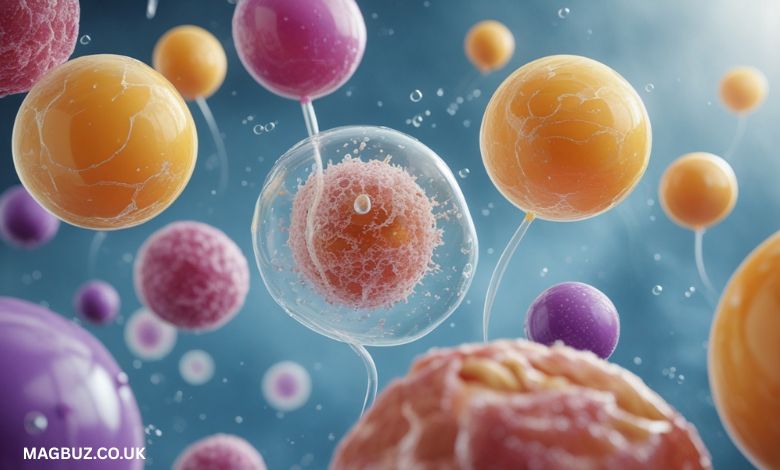Discovering Cellulysis: The Science of Cells Bursting Open

Introduction
Imagine your body is full of tiny balloons called cells. These balloons hold important stuff inside, like tiny factories making energy or storing food. Sometimes, we need to pop those balloons carefully to see what’s inside or to help our bodies work better. That’s where cellulysis comes in!
Cellulysis is like a gentle pop for cells. It happens in nature and in labs. Scientists use it to learn about life, and doctors use ideas from it to make skin smoother. This guide explains cellulysis in easy words. It’s for kids, families, and anyone curious about the cool world of cells. We’ll use simple stories, like comparing cells to soap bubbles, to make it fun. By the end, you’ll know why cellulysis matters and how it helps us every day.
Ready to dive into the world of popping cells? Let’s go!
What is Cellulysis?
Cellulysis sounds like a big word, but it’s simple: it’s when a cell’s outer wall or skin breaks open. Cells are the building blocks of all living things—plants, animals, even you! Each cell has a tough cover to keep its insides safe. Cellulysis breaks that cover to let out goodies like proteins, DNA, or even fat bits.
Think of a cell like an orange. The peel is the wall, and the juicy inside is what we want. Cellulysis peels it open without squishing everything. This process is natural in our bodies, like when old cells die and release parts for new ones. But people also make it happen on purpose in science.
In biology, cellulysis targets different cell types. Plant cells have thick walls made of a strong stuff called cellulose, like cardboard. Animal cells have softer skins. Bacteria have their own special walls. Each needs a special way to open up.
Why do we care? Because inside cells are secrets to health, food, and fun inventions. Without cellulysis, we couldn’t study diseases or make yummy juices from fruits.
The Basic Steps of Cellulysis
Cellulysis isn’t random—it’s a step-by-step adventure:
- Spot the Cell: Pick the right cells, like fat cells under skin or plant cells in leaves.
- Break the Wall: Use tools or tricks to crack it open.
- Collect the Goods: Grab what’s inside without messing it up.
- Clean Up: Make sure the bits are ready for use.
This keeps everything safe and useful. Kids, imagine baking cookies: You crack eggs carefully so the yolk doesn’t spill everywhere. That’s cellulysis!
How Does Cellulysis Work? Fun Ways to Pop Cells
Scientists have clever tricks to make cellulysis happen. It’s like having a toolbox for tiny jobs. Here are the main ways, explained with easy examples.
Mechanical Methods: The Strong-Arm Approach
These use push and pull, like shaking a snow globe. Tools grind or buzz cells until they burst.
- Homogenizers: Like a blender for cells. They squish and mix to open many at once. Great for big batches in labs.
- Ultrasonic Devices: Sound waves zap like a superhero’s power. The vibrations shake walls apart. Fun fact: It’s the same tech in cleaning jewelry!
- Bead Mills: Tiny balls tumble cells like clothes in a dryer. Bang! Walls break.
These are fast but need care so insides don’t get smashed.
Chemical and Enzymatic Tricks: Smart Dissolvers
No brute force here—use magic potions or helpers.
- Detergents and Solvents: Soapy chemicals slip in and melt walls, like dish soap popping bubbles.
- Enzymes: Nature’s scissors! Cellulase is an enzyme that chews cellulose in plants. It’s like a key unlocking a door. Safe and picky—only cuts what it needs to.
Enzymes are stars in green science, turning plant waste into fuel.
Physical Methods: Nature’s Free Helpers
Sometimes, simple changes do the trick.
- Freeze-Thaw Cycles: Freeze cells so ice crystals poke holes, then thaw. Repeat like playing hot-cold tag. Easy at home labs!
- Osmotic Shock: Dunk cells in salty or sugary water. They swell and pop like overfilled water balloons.
Each method fits the job. For tough plant cells, enzymes win. For soft animal cells, freeze-thaw is gentle.
Why is Cellulysis So Important?
Cellulysis isn’t just popping balloons—it’s a hero in science and health. It helps us unlock life’s mysteries.
In biology, it lets researchers peek inside cells. Want to fight germs? Cellulysis pulls out virus parts for vaccines. Studying cancer? It grabs DNA to see what’s wrong. Without it, medicine would be stuck.
In nature, cellulysis recycles. When leaves fall, bugs and bacteria use it to break down bits, feeding soil. It’s Earth’s cleanup crew!
For the future, cellulysis powers green tech. Imagine cars running on plant goo turned to fuel via cellulysis. By 2025, experts predict more biofuels from this process, cutting pollution.
But wait—cellulysis helps beauty too! More on that next.
Cellulysis in Medicine and Health
Doctors borrow from cellulysis to fix bodies. In treatments, it targets bad spots, like extra fat causing bumpy skin (called cellulite). By breaking fat cell walls, the body sweeps away junk naturally.
This keeps you healthy without big cuts. It’s like a mini cleanup inside your skin.
Key Date: Mesotherapy ideas for cellulysis started in the 1950s in France, but boomed in the 2000s with safe cocktails.
Cellulysis in Everyday Life: From Labs to Your Skin
Cellulysis pops up everywhere! Let’s see real-world magic.
In Food and Drinks
Ever sip orange juice? Cellulysis squeezes out the yum without bits. Winemakers use it for clear pours. It’s in cheese-making too—breaking milk cells for creamy texture.
In Green Energy
Plants hold energy like locked treasure. Cellulysis unlocks it for bioethanol, a clean gas. Farms turn corn stalks into fuel, helping fight climate change.
In Cosmetics: Smoothing Skin with Cellulysis
Here’s where it gets exciting for grown-ups and teens. Cellulite makes skin look dimply, like cottage cheese on thighs. Cellulysis treatments pop those fat pockets gently.
One star is the Meso Cellulysis Cocktail from MesoMedica. It’s a mix injected in tiny shots (mesotherapy). Ingredients like caffeine and enzymes do the popping work.
- Phosphatidylcholine (PPC): Melts fat walls.
- L-Carnitine: Turns fat to energy, like fuel for muscles.
- Caffeine: Wakes up blood flow, reducing puffiness.
Sessions: 4 to 8 over weeks. Results? Smoother skin in 2-4 weeks. Mild redness fades fast. Always see a pro—safe but not for everyone.
Kids, think of it as a spa for cells! It helps moms feel confident in shorts.
Other Cool Uses
- Vaccine Making: Pop germs to train your body’s guards.
- Animal Feed: Break plant walls so cows eat better.
Cellulysis connects science to fun!
Fun Experiments You Can Try at Home (With Grown-Up Help)
Want to see mini-cellulysis? Safe kitchen science!
- Strawberry DNA Pull: Mash berries (breaks cells), add soap (chemical lysis), and pull stringy DNA. See cell secrets!
- Yeast Pop: Mix yeast in warm water with sugar. Bubbles show cells bursting to make gas.
These show how easy and exciting cellulysis is.
FAQ
What is the difference between cellulysis and cell death?
Cellulysis is a controlled break for useful release. Cell death is when a whole cell stops working, but it can lead to natural cellulysis.
Is cellulysis safe for skin treatments?
Yes, when done by experts. Side effects are rare, like light swelling for a day. Check with a doctor first.
Can kids learn about cellulysis in school?
Absolutely! It’s in basic biology: how cells divide or recycle. Teachers use balloon demos.
How long do cellulysis beauty results last?
Up to 6-12 months with healthy habits like exercise. Touch-ups help.
Does cellulysis hurt the environment?
No! In biofuels, it uses waste plants, cutting trash.
Conclusion
We’ve journeyed through the world of cellulysis, from popping plant walls for fuel to smoothing skin for smiles. This tiny process powers big changes—in labs, kitchens, and clinics. It shows how breaking things open can build better things, like healthier bodies and a greener planet.
For kids, remember: Cells are like friends sharing toys when walls come down. For all, cellulysis reminds us life’s full of hidden wonders. Next time you eat fruit or see smooth skin, think of those gentle pops!
Stay in touch to get more updates & alerts on Magbuz! Thank you




